Growing winter squash is one of the most rewarding experiences in the garden. With the right care, you can harvest flavorful, nutrient-rich squash that stores well for months, providing homegrown goodness long after the growing season ends. Over the years, I’ve grown a wide variety—including butternut, acorn, delicata, and kabocha—and I’ve learned firsthand what works (and what doesn’t) when it comes to planting, pollination, pest control, and curing for long-term storage.
I’ve made my share of mistakes, from planting too early in cool soil to battling stubborn squash vine borers. But with each season, I’ve refined my approach, and now I’m sharing my best tips with you. In this guide, I’ll take you step by step through selecting the right varieties, planting at the optimal time, caring for your plants, troubleshooting common issues, and ensuring a successful harvest.
Whether you’re a first-time gardener or looking to improve your squash yields, this guide will provide you with practical, experience-backed advice to help you grow an abundant crop. Let’s dig in!
Winter Squash Overview
Native Americans called it isquoutersquash. The British call it marrow. Squash is the American English term.
Winter squash is a group of hardy, long-season vegetables known for their thick, inedible rinds and sweet, nutty flesh. Unlike summer squash, which is harvested young and tender, winter squash is left to fully mature on the vine, developing a protective outer skin that allows it to be stored for months after harvest. Popular varieties include butternut, acorn, spaghetti, kabocha, and Hubbard squash, each with its own unique flavor and culinary uses. These squash thrive in warm weather but are harvested in late summer or fall, making them a staple for hearty winter meals.
Winter squash and summer squash differ primarily in their harvest time, skin texture, and storage ability. Winter squash, such as butternut, acorn, and spaghetti squash, is grown for long-term storage and is harvested when fully mature, with a hard, thick rind that protects the flesh inside. This tough skin allows winter squash to be stored for months without refrigeration. In contrast, summer squash, like zucchini and yellow squash, is harvested young and tender, with thin, edible skin and a high moisture content, making it more perishable. Additionally, winter squash varieties require a longer growing season and are typically vine-growing, whereas many summer squash types grow in bush form and produce fruit continuously throughout the season.
Plant squashes in full sun in compost-rich, well-drained soil. Squash likes to get its start in the spot where it will grow, but if you want to get a jump on the season, start seed indoors 3 to 4 weeks before the last expected frost in 4-inch biodegradable pots (that can be set directly in the ground at planting time so that the roots are not disturbed). A week before transplanting, harden off seedlings by cutting back on the water and lowering the nighttime temperature to 65°F.
Related articles:
- How to Grow Summer Squash and Zucchini: A Gardener’s Guide
- The Ultimate Guide to Growing Winter Squash
- Squash Seed Starting Tips: How to Grow Strong, Healthy Plants from the Start
- Growing Squash in Small Spaces: Trellising & Container Growing
- How to Maximize Squash Pollination for Bigger Harvests
- The Best Winter Squash Varieties for Your Garden
- The Best Summer Squash & Zucchini Varieties for Your Garden
- How to Harvest and Store Summer Squash
- Harvesting & Storing Winter Squash for Long-Term Use
- How to Prevent and Treat Squash Pests and Diseases Naturally
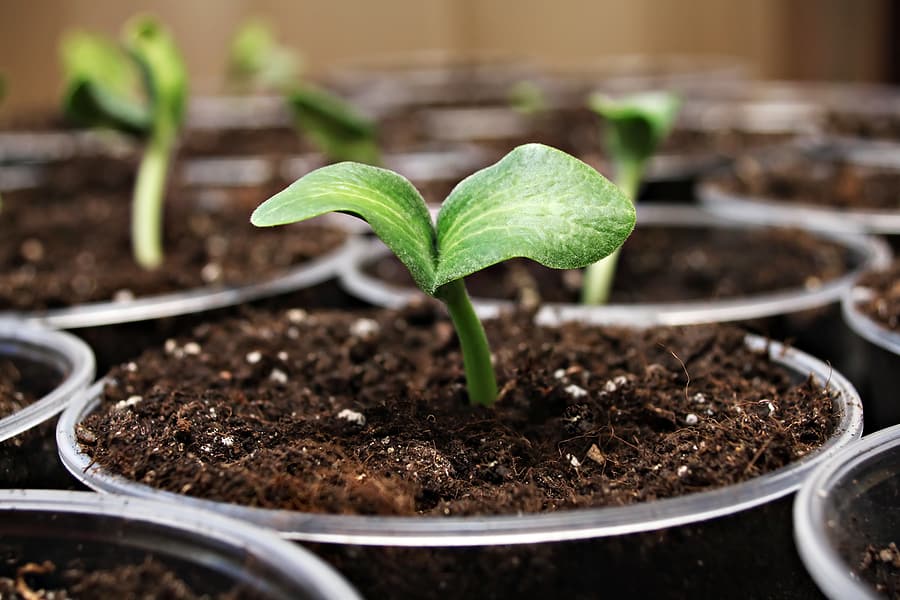

Squash Growing Quick Tips
- Site: Squash requires full sun, warm weather, and good air circulation to mature. Squash grows best in growing zones 3-10. If your growing season is short, choose a bush variety squash that will mature more quickly.
- Soil: Plant squash in humus-rich, well-drained soil; work in organic compost in the autumn before planting or spread compost in the growing bed during the growing season. Bush-type varieties can be grown in containers.
- Planting: To get a jump on the season, start summer and winter squashes indoors 3–4 weeks before the last frost. Sow squash outdoors or set out seedlings when the soil temperature reaches 70ºF (21ºC). Sow seed ½ inch–1 inch (13mm–2.5 cm) deep. Thin successful plants to 36 inches (90 cm) apart in all directions. Plant several squash plants to ensure at least one is successful and survives pests and diseases. Stagger plantings or plant seeds and transplants at the same time for continuous harvest.
- Mounds: Squash is often planted on slight mounds or hills. Sow 4–5 seeds 2–3 inches (5–7.5 cm) deep, 3–4 inches (7.5–10 cm) apart in hills raised 12 inches (30 cm) spaced 6 or more feet (1.8–2.4 m) apart. Thin to 2 successful plants per hill. If plants are supported on wooden tripods space hills 4 feet (1.2 m) apart.
- Watering: Squash requires regular and even watering. Keep the soil just moist. Avoid overhead watering.
- Feeding: Squash is a heavy feeder; apply lots of compost to the soil and they should do well. You can feed squash with compost tea every couple of weeks during the growing season.
Winter squash
Winter squash is harvested in autumn and stored for winter use. Winter squashes are harvested when their skins are hard. Winter squashes include acorn, buttercup, butternut, Hubbard, and spaghetti.
Winter squash is a frost-tender, warm-season annual. Winter squashes are eaten after they have matured and their skins have thickened and hardened.
Some winter squashes grow fruit as long as 30 inches (76cm). Fruits vary in shape from round to oblong, to cylindrical to turban shaped. Separate male and female flowers appear on the same plant
Winter squashes are grown to maturity on the vine until the skin is very hard (unlike summer squashes which are harvested while the skin is still tender).
Popular winter squashes include Hubbard, butternut, acorn, delicious, banana, Turk’s turban (photo above), cushaw, and spaghetti squash.
- Sow winter squash seeds in the garden–or set out seedlings started indoors–only after the soil has warmed to at least 60°F (16°C), usually no sooner than 3 weeks after the last frost in spring.
- Winter squashes grow best in air temperatures ranging from 50° to 90°F (10-32°C); established fruit will ripen in temperatures as high as 100°F (37°C) but flowers will drop in high temperatures.
- Winter squash requires 60 to 110 days to reach harvest.
- Winter squash yield: grow 1 or 2 summer squash plants per household member.
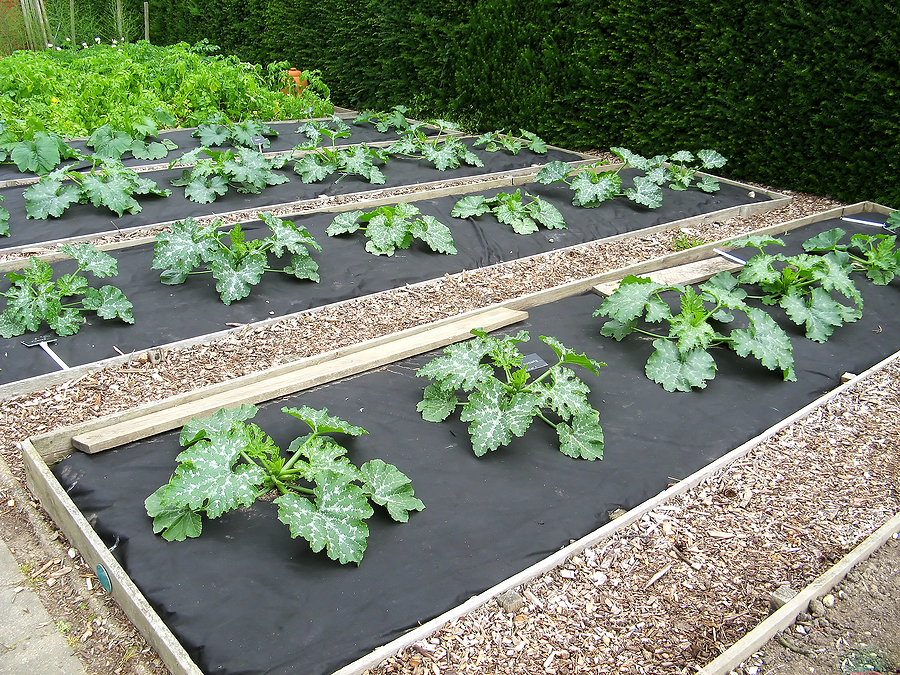
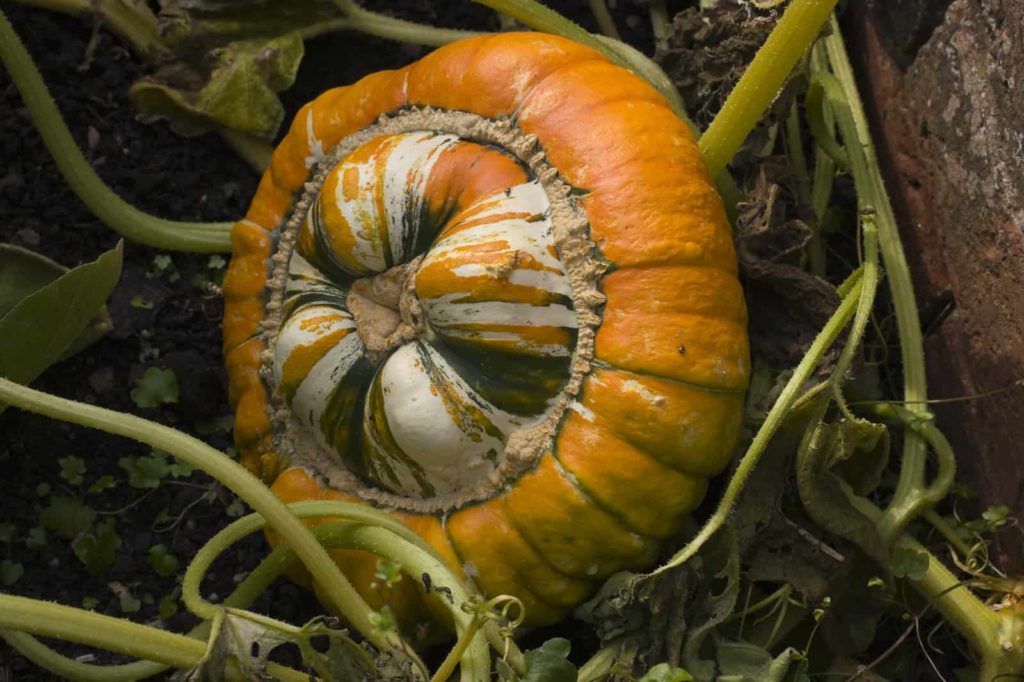
When to plant squash
Sow squash indoors 3 to 4 weeks before the last expected frost in spring. Sow squash outdoors when the soil temperature has warmed to 70°F (21°C). Protect squash in the garden from cool temperatures with row covers.
Squash wants warm soil and air temperatures for growing—the 70s°F is optimal. Squash seeds won’t germinate in cold soil. Wait until the soil temperature has reached 60°F before direct seeding or setting out starts. Lay down a sheet of black plastic to warm the soil before sowing or planting. Plants started in chilly temperatures may become stunted.
- 2-4 weeks before the last frost in spring: start seed indoors for transplanting into the garden later.
- 2-3 weeks after the last frost in spring: transplant seedlings to the garden.
- 3 weeks after the last frost in spring: direct sow seed in the garden; minimum soil temperature is 65°F; protect with row covers if nights or days are cool.
Where to plant squash
- Plant squash in full sun.
- Grow squash in loose, well-drained soil rich in organic matter.
- Prepare planting beds in advance working with plenty of aged compost. Add aged manure to planting beds in the autumn before growing squash.
- Squash prefers a soil pH of 5.5 to 6.8.
- Winter squashes will sprawl and require ample space; if space is tight train them over a small A-frame or up a trellis as tall as 5 to 8 feet (1.5-2.4m).
Squash planting time
Sow squash or set out transplants about 2 weeks after the last expected frost in spring. Sow or plant successive crops 4 weeks later.
- Squashes are frost-tender, warm-season annuals.
- Sow squash seeds in the garden–or set out seedlings started indoors–only after the soil has warmed to at least 60°F (16°C), usually no sooner than 3 weeks after the last frost in spring.
- Start squashes indoors as early as 4 weeks before the last average frost date in spring.
- Sow seed indoors in biodegradable peat or paper pots that can be set directly in the garden so as not to disturb plant roots.
- Squashes grow best in air temperatures ranging from 60° to 75°F (16-24°C); established fruit will ripen in temperatures as high as 100°F (37°C) but flowers will drop in high temperatures.
- Squashes are warm-season crops and very sensitive to cold and frost.
- Squashes require 50 to 65 days to reach harvest.
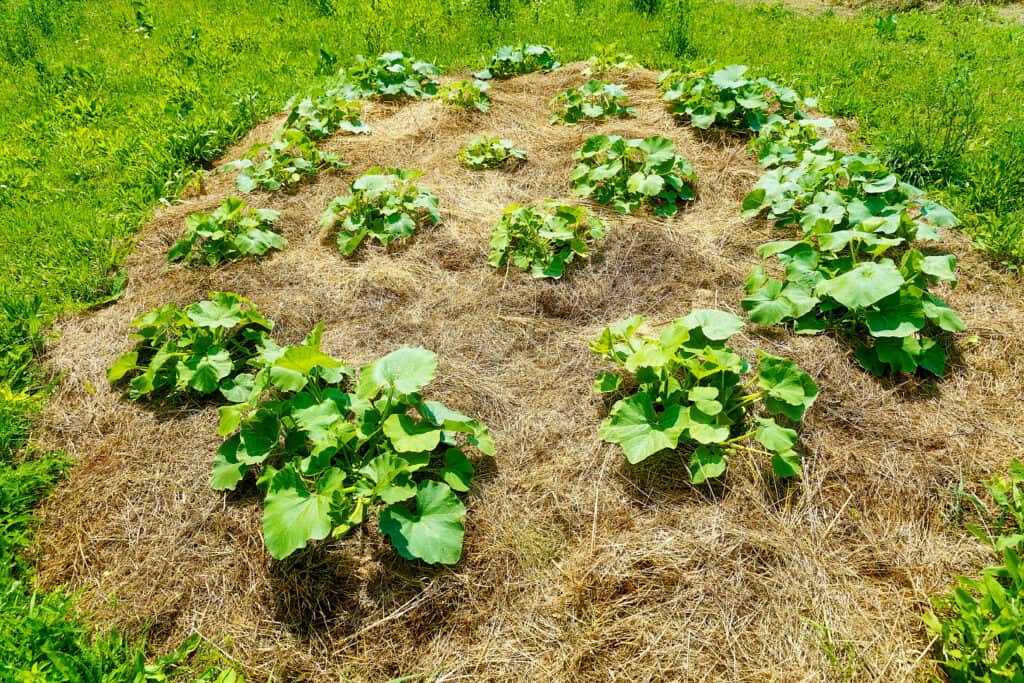
Planting squash
You can avoid a harvest too large (especially for zucchini) by simply not overplanting. One zucchini plant will produce 6 to 10 pounds of fruit over the course of the season. Stagger plantings so that you have a continuous harvest but are not overwhelmed.
Check spacing requirements for each variety you grow. If the garden is tight, contain the plant by pinching out the growing tips after a vine has set a few fruits. Don’t grow squash too close together; this will help deter pests and diseases.
Sow seed or set transplants in raised mounds at least 1 foot across. Place a generous amount of aged compost or aged manure into each planting hill before planting. For an extra early harvest, start seeds in peat pots indoors 3 weeks before the last frost for planting out after the last frost.
- Sow squash seeds 2 to 3 inches deep.
- Sow squash in raised hills or inverted hills with 4 to 5 seeds set 3 to 4 inches (7-10cm) apart; thin to the two strongest seedlings.
- Space hills 6 to 8 feet (1.8-2.4m) apart.
- In rows, plant 2 squash seeds 10 inches (25cm) apart in rows 3 to 5 feet (.9-1.5m) apart; thin successful seedlings in rows to 3 feet (.9m) apart.
- Thin seedlings by cutting off weak seedlings at soil level with scissors so as not to disturb fragile roots.
- Hills or mounds should be 6 to 12 inches (15-30cm) tall and 20 inches (50cm) across. This will allow plants to run down the hill away.
- Inverted hills (basins)–which can be used to retain moisture in dry regions–can be made by removing an inch of soil from an area about 20 inches across and using the soil to form a ring or circle.
- Plant 4 or 5 seeds in each inverted hill.
- Squash Yield. Grow 1 or 2 summer squash plants per household member.
Squash companion plants
Grow squash with celeriac, celery, corn, nasturtiums, melons, onions, radishes, peas, and beans. Avoid growing squash with potatoes.
- Grow winter squash with nasturtiums, bush peas, and beans.
- Avoid planting summer squashes in the shadows of taller plants.
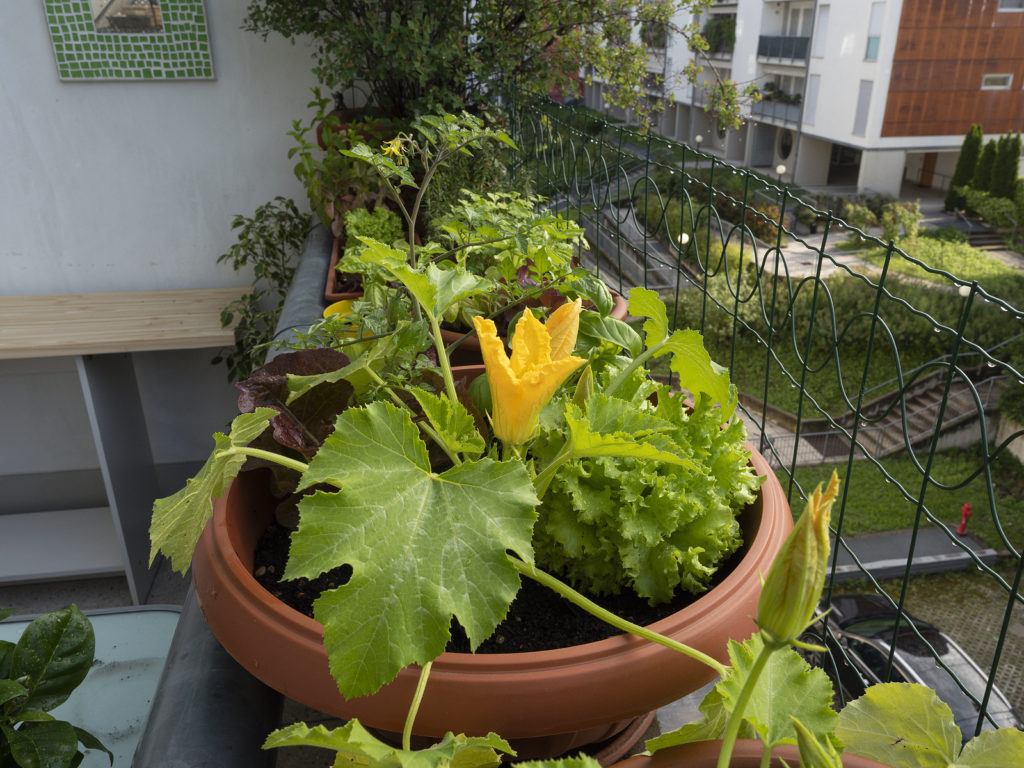
Watering squash
- Squash grows best in soil that is kept evenly moist.
- Squashes require a lot of water in hot weather. Plants may wilt on hot days as they use water faster than the roots can supply.
- As long as the water is regular and deeply applied, wilted plants will liven up as the day gets cooler.
- Squash that is wilted in the morning needs immediate water.
Blossom-end rot. Irregular watering and a soil calcium deficiency can result in poor water uptake that will result in the blossom end of the fruit (opposite the stem) becoming leathery and sunken; this is called blossom-end rot. Use ground oyster shells or a calcium-rich fertilizer to counter blossom-end rot.
Feeding squash
Squash are heavy feeders. Prepare the planting bed with lots of organic matter—a few inches of aged compost spread across the bed and then turned under. If leaves grow pale or plants seem weak, side-dress squash with well-aged compost or use a foliar spray of liquid fish or kelp fertilizer—high in phosphorus for fruit production. Don’t use a fertilizer too high in nitrogen; it will diminish your yield.
- Add aged compost to planting beds before planting and side-dress squash with aged compost at midseason.
- Side dress squash with compost tea or slow-release organic fertilizer every 2 to 3 weeks during the growing season. Avoid feeding squash with high nitrogen fertilizer, 5-10-10 is best.
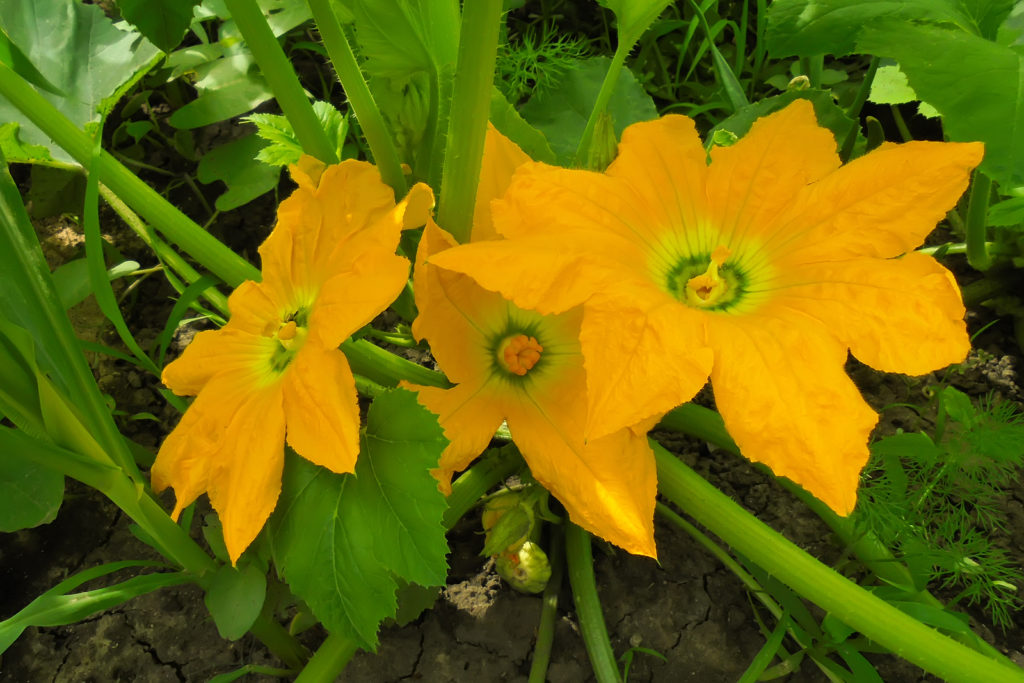
Squash pollination and fruit set
Squash plants have separate male and female flowers on the same plant. Bees must transfer the pollen from the male flowers to the female. Don’t use insecticides in the garden or you will risk killing off your pollinators. If you don’t have bees, you can hand-transfer pollen with a small artist’s paintbrush.
- Squashes have separate male and female flowers.
- The first flowers to appear are male flowers that will not produce fruit.
- Female flowers appear slightly later and are pollinated by the male flowers commonly with the help of insects.
- If pollination is slow or does not occur, use a soft-bristled brush to dust inside a male flower then carefully dust the inside of a female flower (a female flower will have an immature fruit on its stem, a male won’t).
- Once fruits form set each one on a wooden plank so that it does not have direct contact with the soil; this will allow squashes to mature with less exposure to insects.
- If your plants are flowering but not producing fruit, there may not be enough bees around for pollination. Hand-pollinate flowers with a cotton swab—gather pollen from the male flower and dab it onto the golden stigma in the center of the female flower.
Cross-pollination. Squash plants easily cross-pollinate. But cross-pollination affects next year’s crop, not this year’s crop. If you grow zucchini from newly purchased seeds each year, you won’t have to worry about plants cross-pollinating. Only if you save seed, should you grow just one variety at a time.
Squash care
- Once fruits form set each one on a wooden plank so that it does not have direct contact with the soil; this will allow squashes to mature with less exposure to insects.
- Temperatures too cold will pit the skin of summer squash and zucchini. This is called “chilling injury.” Keep a floating row cover handy to cover seedlings and young plants if the temperature dips below 65°F at night.
- Keep the soil evenly moist. Give squash 1 inch of water a week. The critical time for watering is during bud development and flowering. Once plants are established, mulch with straw, hay, or dried leaves to retain soil moisture and suppress weeds. Drought-stressed plants are more susceptible to insect attacks.
Squash pests
Cucumber beetles, squash bugs, and squash vine borers must be controlled to successfully grow squash. Place floating row covers over young squash plants until they start to bloom. This will exclude attacking insects until plants are strong enough to withstand pest damage.
Aphids, cucumber beetles, squash bugs, squash vine borers, and other insects can all attack squash. Use rows covers to protect young plants from cucumber beetles and squash borers; remove covers when the plants bloom. Clean up refuse at the end of the season, and turn the soil in spring to bury insect pupae.
Cucumber beetles emerge from dormancy in spring before the weather is warm enough for cucumbers or squash to begin growing. When squash starts growing, cucumber beetles will begin feeding on leaves and fruits. Check cucumber beetles–little yellow beetles with stripes or spots–with yellow sticky traps or cover plants with a floating row cover, but be sure to remove the cover when flowers appear and it’s pollination time.
Squash vine borers (the larvae of wasp-like moths) bore into squash stems and eat their way through stems. Look for sawdust-like excrement near small holes to know they are present. Plants suddenly wilt and may die. Slit the damaged vine with a sharp knife and remove the borers with tweezers. Cover the damaged section with well-aged compost and the plant will grow on.
- Squash can be attacked by squash bugs, squash borers, and cucumber beetles.
- Handpick or hose away beetles. A small hole in the stem or unexplained wilting may indicate the presence of borers.
- Slit the stem, remove the borers, and dispose of them. Cover the slit stem with soil to encourage root development from that point.
- Squash borers or bacterial wilt can cause squash plants to suddenly wilt and die just as they begin to produce.
Squash diseases
Bacterial wilt, mosaic virus, mildew, blight, and curly top are viruses and fungi that can plague squash. Control disease-spreading pests; plant disease-resistant varieties, and remove and destroy infected plants.
- Plant disease-resistant varieties.
- Water at the base of plants to keep water off the foliage, and do not handle plants when they are wet to avoid the spread of fungal spores.
- Remove and destroy infected plants before they spread disease to healthy plants.
- Bacterial wilt can be spread by cucumber beetles. Handpick and destroy cucumber beetles.
- Powdery mildew, a fungus disease, will cause leaves to turn a gray-white color late in the season. Proper spacing and increased air circulation will help reduce this problem.
- Mosaic virus can cause squash plants to become mottled yellow and stunted. Mosaic virus is spread by aphids. Control aphids and remove affected plants.
- Blossom end rot will cause squash fruit to rot from the blossom end. Blossom end rot is caused by fluctuations in soil moisture. Water evenly and regularly and mulch around plants to conserve soil moisture.
More on diseases and pests: Zucchini and Squash Growing Problems: Troubleshooting.
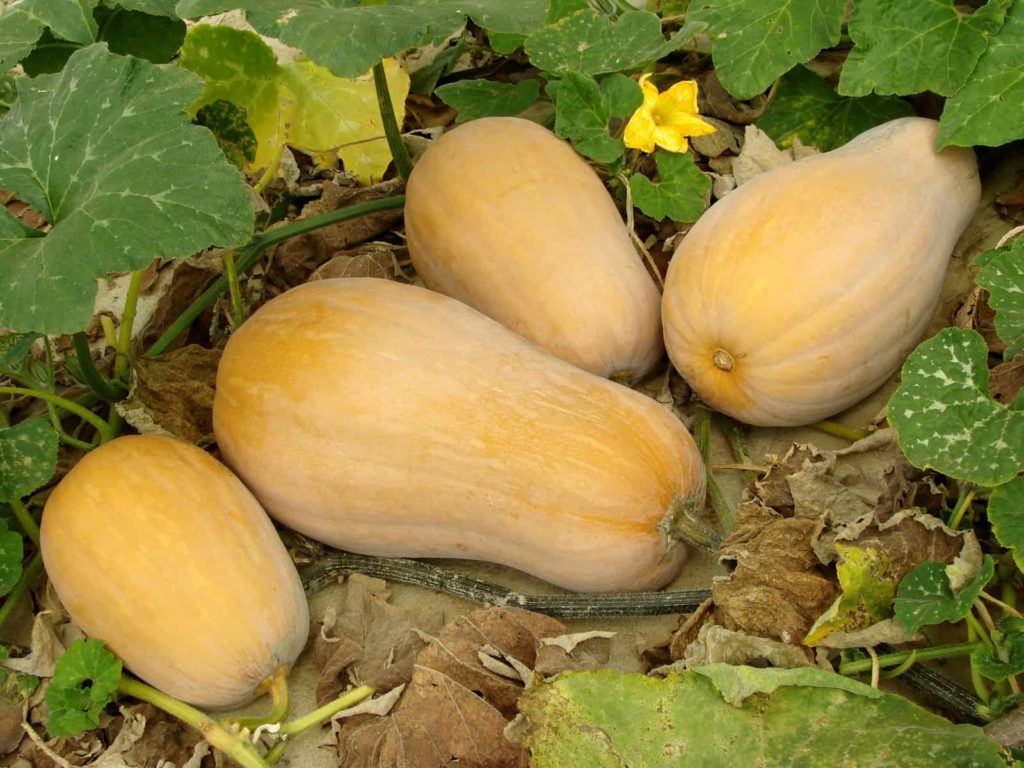
Winter squash harvest
Winter squashes require 80 to 100 days to maturity depending upon the variety. Allow winter squashes to mature fully on the vine until their skins are extremely hard before harvesting. Harvest winter squash before the first frost.
After harvest, winter squash should be allowed to cure outdoors; dry and toughen the skins by exposing winter squash to the sun for 5 to 7 days or place the squash in a cool, dry ventilated area for 5 to 6 months.
Cure winter squash for storage by placing them in a hot, dry place for three weeks. Curing will toughen the skin so that it will keep through the winter.
- Winter squashes are ready when rinds are full color and firm (some acorn squash may be green and have semi-hard rinds).
- Winter squashes should be allowed to mature fully on the vine.
- If the rind cannot be dented with your thumbnail, it is ready for harvest.
- Complete the harvest before the first hard frost.
- Stems and vines will be hard and dry at harvest time.
- Cut squash from the vine leaving 2 to 3 inches (5-7cm) of stem above the fruit; this will allow the squash to store longer. Use a knife, pruning shears, or lopper to cut thick stems. Keep pruners clean so as not to spread the disease to other plants.
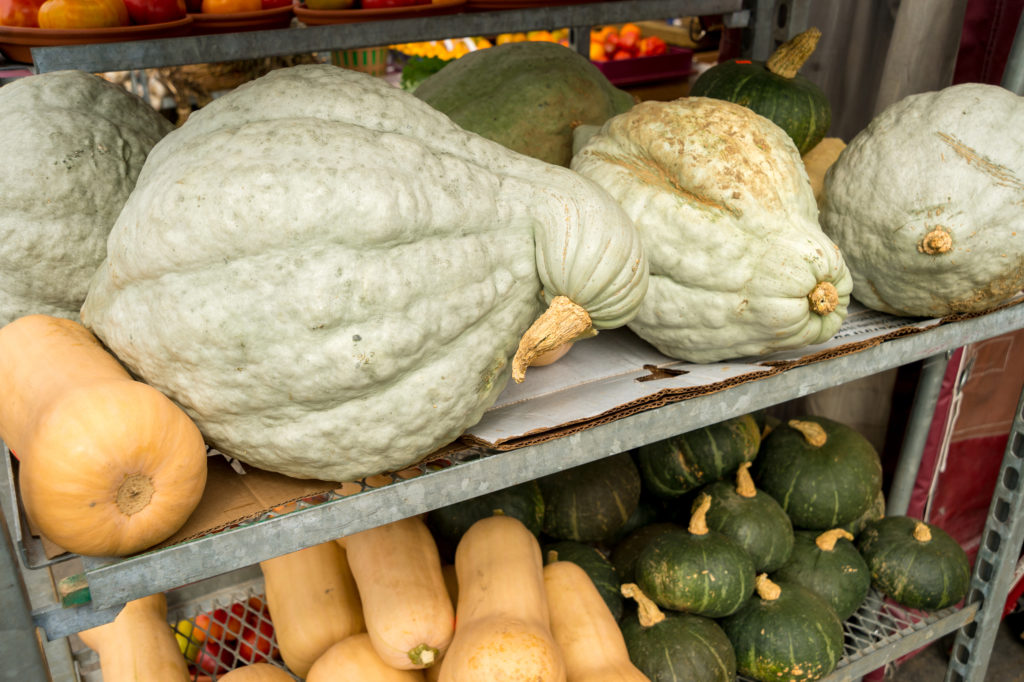
Storing and preserving winter squash
- Winter squashes require curing before storing.
- Cure squashes in the sun for a week or more or place them in a dark, humid place for 10 days at 80° to 85°F (26-29°C).
- After curing store winter squash at 50° to 60°F (10-15°C) in a dry, dark place.
- Winter squash will keep for 5 to 6 months. Winter squash with soft skin will likely rot in storage; these squash should be cooked right away.
- Do not wash squashes until you are ready to use them.
- Cooked squash can be frozen, canned, pickled, or dried.
Winter squash varieties to grow
Winter squash varieties include acorn, banana, buttercup, butternut, cushaw delicious, Hubbard, marrow, spaghetti, turban, and pumpkins.
- Acorn: Autumn Queen, Bush Table Queen, Carnival, Cream of the Crop, Ebony Acorn, Gill’s Golden Pippen, Heart of Gold Jape, Table Ace, Table Gold, Table King, Table Queen Tay Belle, stuffy Acorn.
- Banana: Pink Banana Jump.
- Butternut: Early Butternut, Harris Butternut, Nicklow’ Deligh, Ultra Neck Pumpkin, Waltham Butternut, Zenithg Butternut.
- Hubbard: Baby Blue Hubbard, Little Gem, New England Blue Hubbard, Sweet Meant, Warted Chicago Hubbard.
- Spaghetti: Pasts, Pasts Spaghtetti, Stripetti, Tivoli Spahgetti, Vegetable Spaghette.
- Sweet Potato: Delciats, Sugar Lpoad, Sweet Dumpling, Thelma Sander’s Sweet Potato.
- Turban: Amercup, Autumn Cup, Bitterroot, Burgess Buttercup, Buttercup, Churimen Abobora, Emerald Bush, Honey Delights, Sweet Mama, Turk’s Turban.
- Other: Doe, Flat Whtie Boer, Futtsu Early Balck, Gold Nugget, Hope Pale Grey, Lower Salmon River, Mayo Blusher, Red Kurti, silver Bell, Sweet Meat, Tahitian.
- Novelty: Luffa, Pasta, Stripetti, Tivoli Spaghetti Turk’s Turban, Vegetable Spaghetti.
Winter squashes for cooking
Butternut squash, acorn, and Delicata squash, Hubbard, and kabocha squash—all of these are winter squashes—you cook and serve them when the weather turns cold.
Winter squashes are grown in the summer just like summer squashes, but instead of picking and serving them tender and immature (like summer squash), winter squashes mature on the vine, are harvested just a few days before the first frost in autumn, and are cured and stored for eating one, two, or three months later—autumn into winter into early spring. They gain flavor as they age.
Serve winter squashes diced and sautéed as a side dish, baked, mashed, and simmered in stock as a soup, in gratins with potatoes, moistened with stock or water and baked, in risotto, or simply puréed enriched with butter. Winter squashes are mostly sweet tasting, many with a flavor reminiscent of sweet potatoes.
Three types of winter squash:
There are more than 650 different varieties of winter squashes, but there are just three basic types:
- Those for eating in the fall—acorn, Delicata, and spaghetti squash; species Curcurbita pepo.
- Those for eating in early- to mid-winter—buttercup, banana, Hubbard, and kabocha squash; species Curcurbita maxima.
- Those for eating in late winter and early spring—butternut squash; species Curcurbita moschata.
Choose winter squashes on when you plan to eat them, their flavor, and how you want to cook them.
Here are the three types of winter squashes and recommended varieties in each species:
Squashes for eating in the fall: acorn, Delicata, and spaghetti squash (species Curcurbita pepo).
Curcurbita pepo squashes don’t keep quite as long in storage as those from the other two species, just a few weeks of storing will intensify their flavor. C. pepo squashes turn orange or develop orange spots on their rinds. When the orange spots darken and the stems and skin grow hard, these squashes are ready for harvest. Grow these squashes across most regions.

• Acorn squash (C. pepo) has a sweet, nutty flavor, but is less sweet and drier than many other winter squashes. Acorns are small- to medium size with fluted dark green rinds (acorn-shaped) with orange, yellow, or creamy white streaks. The flesh is pale yellow or pale orange. Acorns mature in 90 days and can be grown in most regions including the cool, short-season areas.
Three acorn squashes worth growing are Golden Acorn, Tuffy, and Table Ace. Golden Acorn, also called Table Gold, has the best flavor of the 25 acorn varieties. It has golden orange skin, grows on a compact bush plant, and is ready for harvest in 90 days. Tuffy is sweeter than the average acorn squash with semi-dry flesh well suited for baking; Tuffy is ready in 90 days and intensifies in flavor within a couple of weeks of curing. Table Ace is a smooth tasty acorn growing almost bush-like; it has a dark green rind and is ready in 85 days.
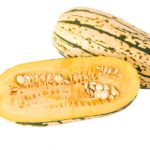
• Delicata squash (C. pepo) has moist, fine-grained, yellow flesh, and outstanding flavor reminiscent of sweet potato. Delicata has edible skin and is well suited for roasting and grilling. It is an heirloom dating from 1894 ready to harvest in 90 to 120 days. Delicata weighs 1 to 2 pounds and is long and cylindrical with a pale yellow rind that is striped or mottled in shades of cream, green, and orange. Sugarloaf is a sweet-flavored Delicata-type squash shaped like a pumpkin weighing 1½ pounds. Delicata JS is flavorful, oblong, green, and white-striped weighing 1½ pounds.
• Dumpling squash (C. pepo) is a sweet potato-flavored fruit with tender flesh suited for roasting. It is small (just ½ pound), globe-shaped, green and white striped, and grows on short vines ideal for small gardens. Sweet Dumpling is a recommended variety.

• Spaghetti squash (C. pepo) is an oblong squash with slightly nutty-flavored, stringy, noodle-like, gold-yellow flesh that is often cooked as a pasta substitute. Spaghetti squash can be boiled or baked and topped with marinara or creamy white sauce. One squash is enough for a family meal. It is yellow-skinned and ready for harvest in 73 days and should be used within three months of harvest. It is widely grown. Hasta La Pasta is a spaghetti variety with oblong fruit 6 to 8 inches long growing on compact plants.
Squashes for eating in early- to mid-winter: buttercup, banana, Hubbard, and kabocha squash (species Curcurbita maxima).
Curcubita maxima squashes are dry fleshed and rich flavored, well suited for baking. They grow sweeter with storage reaching the peak of flavor in mid-winter. These squashes are good keepers, lasting two months in storage. They grow big on sprawling vines and tolerate both cool and dry, arid growing conditions. They are ready for harvest when at least three-quarters of the stem’s surface has turned dry and corky, in 105 to 120 days.
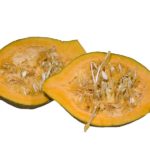
• Hubbard squash (C. maxima) is a mild-flavored, medium to large round squash with nearly pointed ends and a lumpy body usually green to blue-gray. The flesh is grainy and yellow-orange. Use this squash for baking, pies, and soups and as a substitute for pumpkin in recipes. Hubbards are ready to harvest about 100 days after sowing.
• Banana squash (C. maxima) is a mild-flavored and hefty fruit, weighing up to 30 pounds or more. Banana squash is long, cylindrical with green-gray or pink rinds and orange flesh. Blue Banana and Pink Banana are the most flavorful. Blue Banana is gray-green skinned and bears fruit 25 to 30 pounds. The fruit is ready for harvest in 105 to 120 days. Pink Banana has deep pink fruits weighing 15 to 30 pounds and is ready for harvest in 100 to 120 days.
• Buttercup squash (C. maxima) is sweet potato flavored with slightly moist (semi-dry) flesh. Buttercup is a squat, round, and dark green squash with a button or turban on the blossom end. The fruit is slate gray or dark green with pale stripes and weighs 3 to 5 pounds. Buttercup is ready for harvest 90 to 100 days after sowing. Three tasty buttercup varieties are Bitterroot Buttercup which weighs 2½ to 4 pounds and is very sweet; Mooregold which weighs 3 to 4 pounds and has excellent flavor; and Autumn Cup which weighs 3 to 5 pounds and grows on a semi-bush vine, a good choice for small spaces.
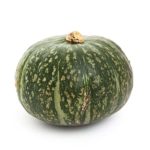
• Kabocha squash (C. maxima) is a sweet-tasting squash after several weeks of storing—prepare in mid-winter. It has a smooth but dry, flaky flesh well suited for baking or mashing. It is round, dark green, or orange-skinned and large weighing 20 pounds or more (kabocha means pumpkin in Japanese). Kabochas grow well in drier climates but are adapted to most regions. They are ready for harvest in 90 to 100 days. Two tasty kabocha varieties are: Cha-Cha a small 4 to 5-pound hybrid that stores well and has fine flavor, and Johnny JWS 6303 which weighs up to 4 pounds has a dark green rind and sweet dry flesh.
Squashes for eating in late winter and early spring—butternut squash (species Curcurbita moschata).
Curcurbita moschata squashes store long, well into late winter and early spring. They include the butternut squash, the Long Island Cheese squash, and several semi-tropical and tropical squashes. These squashes have solid stems and so are unattractive to squash vine borers, which plague many squashes. They like heat and humidity and do well in very warm climate gardens. Because they ripen late they are not a good choice for short-season gardens.
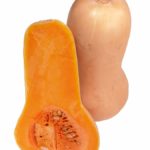
• Butternut squash (C. moschata) is the tastiest—sweet, creamy, and nutty flavor, the most widely adapted of this species, and easiest to grow. It is most flavorful after three months of storage and so can be enjoyed late winter to early spring. Butternut is large, elongated, and pear-shaped with a smooth yellow to butterscotch-colored shell and orange flesh. It is ready for harvest about 105 days after seeding when the fruits turn from pale tan to dark tan, just before frost hits. Butternut squashes should be cured in a warm, dry place for several days immediately after harvest to seal the skins and dry out the stems. Then they should be stored in a dry, airy space. There are 200 varieties of butternut squash. Good choices are: Waltham Butternut which weighs 3 to 6 pounds, has light tan fruit, and grows on a vigorous, productive vine; Butternut Supreme which grows on short vines and is suited for a small garden; Burpee’s Butterbush which has fruit weighing just 1½ pounds on a compact vine; and Nicklow’s Delight a semi-bush hybrid for small gardens that does well in hot summer regions.
More winter squash varieties for cooking
- Acorn (C. pepo): somewhat oval and acorn-shaped with ribbed, dark green skin, and orange flesh. The flesh is tender and fine-textured with a flavor that hints of hazelnuts and pepper. To prepare, remove the seeds and bake. You can eat this one directly from the shell. This variety keeps for 30 to 50 days.
- Banana (C. maxima): a cylindrical squash that can grow between 20 and 24 inches (51-60 cm) long and about 6 inches (15 cm) in diameter. The banana squash can be ivory or pinkish or bluish-gray skinned with firm, fine-textured, orange flesh.
- Buttercup (C. maxima): a variety of turban winter squash. It ranges in size from 4 to 8 inches (10-20 cm) in diameter and from 2 to 3 inches (5-7.5 cm) tall. It has a light blue-gray turban crown with a dark green shell flecked with gray. The flesh is orange and tastes a bit like a sweet potato. This squash can be baked, steamed, or simmered. This buttercup will weigh about 3 pounds (1.4 kg) and can be stored for about 1 month.
- Butternut (C. moschata): large, cylindrical to pear-shaped from 8 to 12 inches (20-30 cm) long and 3 to 5 inches (7.5-13 cm) in diameter. This winter squash can weigh from 2 to 3 pounds (.9-1.4 kg). The color of its skin ranges from yellow to camel. The finely textured flesh is sweet and deep orange. You can bake, steam, or simmer this squash. Avoid this squash if it has greenish skin.
- Calabaza (C. moschata): general name for warm-climate pumpkins. In the United States, the name calabaza is applied to a rounded to pear-shaped squash with mottled skin—deep green, orange, amber, or buff and speckled or striated averaging about 10 pounds and 9 to 10 inches (23-25 cm) in diameter. The orange flesh is can be bland and watery or slightly sweet. Use in stews, soups, and purées.
- Delicata (C. pepo): an heirloom squash introduced in 1894. Delicata is a small, elongated or rounded ribbed squash from 6 to 9 inches (15-23 cm) long, green-striped, and flecked edible skin with pale yellow, sweet flesh. Good for stuffing and baking, even right after harvest without curing. Sometimes called ‘Sweet Potato Squash’.
- Green-Striped Cushaw (C. argyrospyma): pear-shaped squash with a long, thin neck, 16 to 20 inches (41-51 cm) long, weighing 12 to 16 pounds. Thick creamy-white skin mottled with green and moist, coarse flesh that is bland tasting. Popular home-garden variety and farmers’ market variety but not the best quality.
- Hubbard (C. maxima): oval to round squash with a thick rind ranging in color from dark green to gray-blue or orange-red. This squash has a dry, grainy texture and yellow-orange flesh. The Hubbard is less sweet than other winter squashes. It is best boiled or baked and can be mashed or puréed. It will store for up to 6 months.
- Jarrahdale pumpkin or Australian pumpkin (C. maxima): Australian cultivar with heavily lobed sides (looks like a “classic” pumpkin), 13-15 inches (32-38 cm) in diameter. Green-gray skin and deep orange, smooth, creamy flesh that is slightly sweet. Use in pies, soups, bread, or cookies.
- Kabocha (C. maxima, C. moschata): includes several varieties of Japanese squash with a rich, sweet flavor and almost fiberless flesh. (“Kabocha” means squash in Japanese.) Generally a medium-sized and flattened globe-shaped fruit usually glossy dark green or lightly mottled or striped skin with orange flesh. Baked or steamed the flavor will balance between sweet potato and pumpkin. Can also be braised, deep-fried in tempura batter, or simmered.
- Pumpkin and mammoth pumpkin (C. peppo, C. maxima): Two different species of winter squash: the pumpkin or sugar pumpkin (C. peppo) is used for jack-o’-lanterns or pies; and the mammoth pumpkin (C. maxima) is grown for “giant pumpkin” contests. The sugar pumpkin is orange and furrowed and is small- to medium-sized usually weighing between 2 and 20 pounds (.9-9 kg). The sugar pumpkin is related to the acorn squash and zucchini. Besides its edible flesh, the sugar pumpkin has hull-less, edible seeds. The mammoth pumpkin is related to the Hubbard squash. The mammoth is very large with pinkish-orange or grayish-green skin and can be pear-shaped, bulging where it touches the ground. The mammoth pumpkin can grow to more than 100 pounds (45.5 kg).
- Rouge Vif d’Etampes or Cinderella (C. maxima): developed in France in the early nineteenth century, a classic beautiful European pumpkin about 11 inches (28 cm) in diameter with deep-flame color and weighing about 30 pounds. The deep yellow flesh is stringy and not flavorful. Can be baked, simmered, microwaved, or steamed.
- Spaghetti (C. pepo): spaghetti squash is also called vegetable squash. This watermelon-shaped squash has a skin-colored creamy-yellow. The spaghetti squash gets its name from its yellow-gold flesh which separates into spaghetti-like strands when cooked. This squash will average from 4 to 8 pounds (1.8-3.7 kg). It will store at room temperature for up to 3 weeks. After this squash is baked, the strands can be served with a sauce just like pasta.
- Sweet Dumpling (C. pepo): Plump, flattened globe-shaped squash about 4 inches (10 cm) in diameter. Ivory-colored skin with dark-green stripes and a very sweet, fine-textured, pale yellow flesh. Use for stuffing. Does not need curing; stores for 3 to 4 months.
- Turban (C. maxima): this is a family of winter squashes which includes the buttercup squash. At the blossom end, this squash looks like a turban. Turban squashes range in size from 2 to 15 inches (5-76 cm) in diameter at the base. The skin colors vary from bright hues of orange, green, and yellow. The flesh is fine-textured and very sweet with a hazelnut flavor. Turban squashes can be baked, steamed, or simmered.
Blue Hubbard squash
The Blue Hubbard Squash—which is also called the New England Blue Hubbard—is a great choice for sweet-tasting winter squash to serve on a cold, late autumn evening. The flesh of the Blue Hubbard is deep orange. It is dense and starchy and has the nutty, sweet taste of a sweet potato.
The Blue Hubbard is best steamed or baked. You can serve it topped with brown sugar or maple syrup and a pat of butter right in the empty seed cavity. It can also be mashed or puréed with butter and seasoning before serving.
Unlike summer squashes, winter squashes like the Blue Hubbard are allowed to mature on the vine. Their skin is hard and inedible—unlike summer squash such as zucchini. While winter squashes get their start in the summer alongside summer squashes, their thick rinds allow them to be stored for many months—right through the winter.
The Blue Hubbard grows to about 12 inches (30 cm) in diameter and can weigh from about 11 to 20 pounds (4.9 to 9 kg). It has dusky gray-blue skin. There is an orange golden-skinned version of the Blue Hubbard–called the Golden Hubbard–which is slightly smaller and is more orange on the inside and out than golden. But the Golden Hubbard is less flavorful and hardly sweet at all.
About squash
- Squashes are a large group within the cucumber family, Cucurbita, and include winter squashes, summer squashes, and pumpkins.
- Squashes have large, broad leaves; 4 to 6 stems or vines grow from a central root. Some winter squashes are sprawling; others are bush-like.
- Winter squashes have a distinct seed cavity, unlike summer squashes.
- Summer squash botanical name: Cucurbita species
- Winter squash botanical name: Cucurbita maxima and Cucurbita moschata
- Origin: American tropics
Squash frequently asked questions
Q: What kind of soil is best for growing squash?
A: Squash thrives in a wide variety of soils. Loamy soil rich in organic matter retains moisture better. Mound humus soil to create a hill; then plant three squash atop the hill and allow them to run down the fill.
Q: When and how should squash seeds be planted?
A: Sow squash seeds about the same time tomato transplants are set in the garden–after all danger of frost is past. Plant squashes on hills at least 6 feet apart, or thin single plants in rows to 4 feet apart. Winter squashes need 100 to 130 days to mature. They must be harvested before the first fall frost.
Q: When should squash be harvested?
A: Leave winter squash on the vine until just before the first hard frost. This will allow the squash to fully mature. They must have a hard find to store well. Avoid bruising or scratching the squash; injury can leave the squash susceptible to rot. Cut the squash from the vine with a pruner or sharp knife and be sure to leave several inches of dried stem attached to the squash.
Q: What is the best way to store winter squash?
A: Store winter squash at about 45° to 50°F in a dry place. Wipe the squash with a light bleach and water solution to kill fungi and bacteria on the surface. Store the squashes on shelves so that they are not touching; a place with good air circulation is best. Check the squashes regularly to be sure no rot sets in; use squashes with damaged skin first. Winter squashes will store for 3 to 4 months.
Books to help you grow:
- Vegetable Garden Almanac & Planner
- Kitchen Garden Grower’s Guide Vegetable Encyclopedia
- Vegetable Garden Grower’s Guide
- Tomato Grower’s Answer Book
Squash articles at Harvest to Table:
How to Grow Summer and Winter Squash
How to Plant and Grow Pumpkins
How to Harvest and Store Summer Squash
How to Harvest, Cure, and Store Winter Squash
How to Harvest and Store Pumpkins
Eight Ways to Cook and Serve Summer Squash
Seven Ways to Cook and Serve Winter Squash
How to Make Creamy Pumpkin Soup
How to Cook and Serve Squash Blossoms
Squash Growing Problems: Troubleshooting
Squash Vine Borer Organic Pest Control
Squash Bug Organic Pest Control
Corn, Beans, and Squash: The Three Sisters
More how to grow articles:
Learn how to plant, grow, and harvest your favorite vegetables. Click below for all you need to know.
- Artichoke
- Arugula
- Asparagus
- Beans, Snap
- Beets
- Broad Beans
- Broccoli
- Brussels Sprouts
- Cabbage
- Cantaloupe — Melons
- Cardoon
- Carrots
- Cauliflower
- Celeriac
- Celery
- Chard
- Chayote Squash
- Chickpeas
- Chicory
- Chinese Cabbage
- Collards
- Corn Salad
- Corn, Sweet
- Cresses
- Cucumbers
- Eggplant
- Endive and Escarole
- Fava Beans
- Florence Fennel
- Garbanzo Beans
- Garlic
- Horseradish
- Jerusalem Artichoke
- Kale
- Kohlrabi
- Leeks
- Lettuce
- Lima Beans
- Melons
- Mizuna
- Mustard Greens
- New Zealand Spinach
- Okra
- Onions
- Parsnips
- Peanuts
- Peas
- Peppers
- Potatoes
- Pumpkins
- Radicchio
- Radishes
- Rhubarb
- Rutabaga
- Salsify
- Shallots
- Sorrel
- Southern Peas
- Soybeans
- Spinach
- Squash, Summer
- Squash, Winter
- Sunchokes
- Sweet Potato
- Swiss Chard
- Taro
- Tomatillo
- Tomatoes
- Turnips
- Watermelon
- Zucchini



